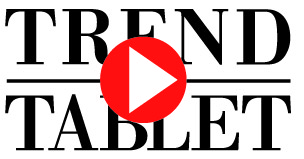TALKING TEXTILES
WAXMAN TEXTILE PRIZE - THE FINALISTS #2015
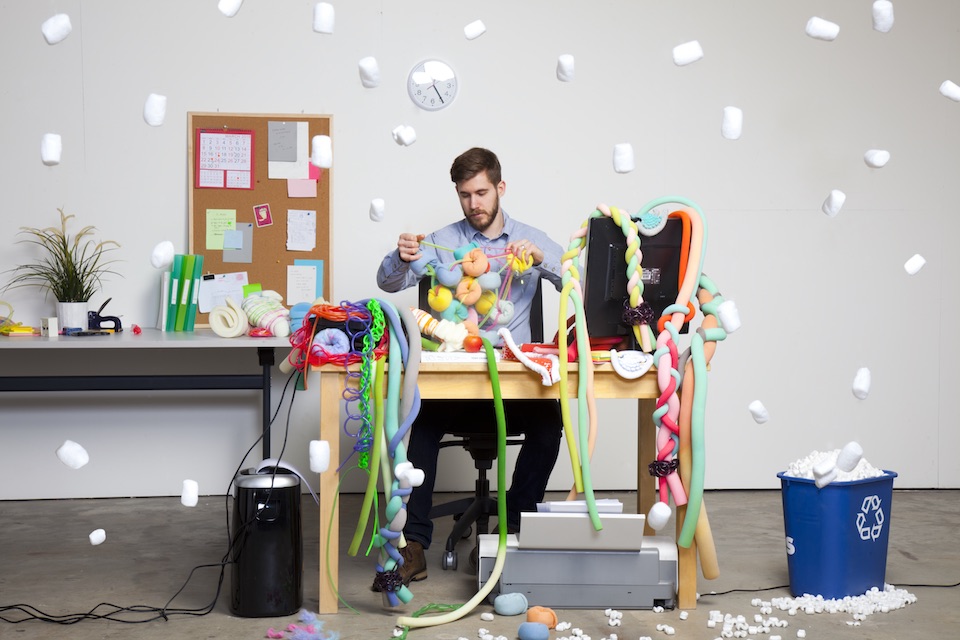
TALKING TEXTILES 2015 finalist Caroline Angiulo, "Mind Wandering Bloom”
We are on a quest to save textiles – to honor and promote them and take them to new dimensions.
It is important to take notice of textiles because they are an endangered species. Mills and factories around the world are vanishing one by one and educational institutions are downsizing their departments or replacing looms with computers therefore soon young talent may have no place to go.
Creativity is the only solution. This is why we have started the inaugural 2015 Dorothy Waxman Textile Design prize , awarding $5,000 to a student whose work fosters the future. An inspiring selection of finalists from more than 200 international entries at Industry City during WANTED Design showcases some of the most innovative ideas today for fashion and lifestyle.
These textiles will speak loud and clear and become the fabrics of life, knitting stories, illustrating pattern, whispering well-being and reviving the act of creative weaving.
TALKING TEXTILES is an initiative that promotes creative textiles. Exhibitions in Milan, Stockholm and Tilburg as well as seminars such as the one in New York on May 13, 2015 bring attention to the plight of the textile industry educating professionals and consumers alike about the importance of fabric design today.
Lidewij Edelkoort & Philip Fimmano
MAY 13, 2015 TALKING TEXTILES SEMINAR tickets
TALKING TEXTILES @ WANTED DESIGN
MAY 9 & 10 + MAY 14 to 19, 2015 from 11:00 AM to 6:00 PM free entrance)
274 36th Street, Sunset Park, Brooklyn
AINE BYRNE (Ireland) Royal College of Art, London
Work in Progress, 2015
technique: screen-printed wovens & jacquards in wool, silk, polypropylene & plastic, accompanied by a film (left)
My Work for my final MA project is concerned with exploring the human life cycle. I create oversized shrouds in many layers, each representing a period of human existence through the specific use of color material and symbolism. These coverings will engulf the human body with each layer, progressively revealing a more elaborate and embellished hand-worked textile.
In my research I have been influenced by various life and death ceremonies including Egyptian mummification where highly luxurious fabrics were contained within the inner layer of the corpses shroud for the journey to the after life.
I am fascinated with the mutability of the human experience and the many metaphorical and physical layers of skin worn and then discarded during life. I wish to highlight and externalise the inner layer of the human spirit. I want these fabricated coffins that will consume the wearer to be filmed on people gradually pealing each covering off, revealing the layers beneath.
The concept of burial and decomposition has lead me to use lots of natural fibers such as wool and silk which will decompose along side synthetic materials such as polypropylene and plastics which will remain in the earth when you have been buried, leaving this memory or the person who has died.
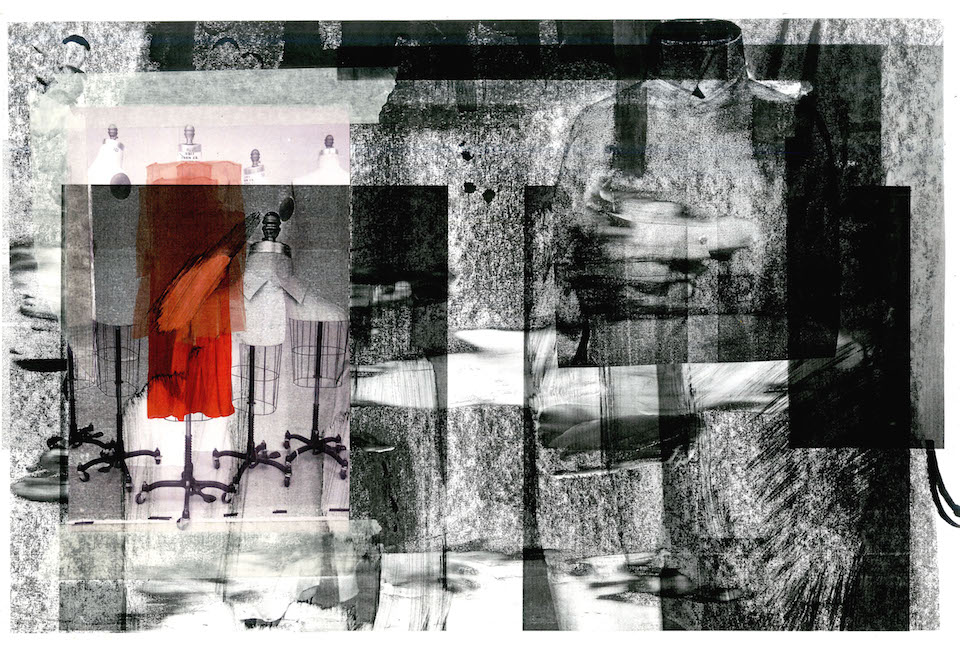
ALICE EARLY (Great Britain)
Parsons, The New School for Design, New York
Plastic Lace (study), 2015
technique: recycled plastic on tulle, sewn, laminated, heat pressed, spray painted & foiled
A combination of textile developments taken from research into being an un-precious precious artist, taking prints from a vintage dress and transforming the prints into ethereal tulle textiles.
Heat pressing recycled plastic onto gathered tulle to create a second lace effect, flaking beautifully. Pressing plastic onto sewn gathered tulle also created a dynamic effect and depth. The combination of textiles layered together to portray a story through the clothes.
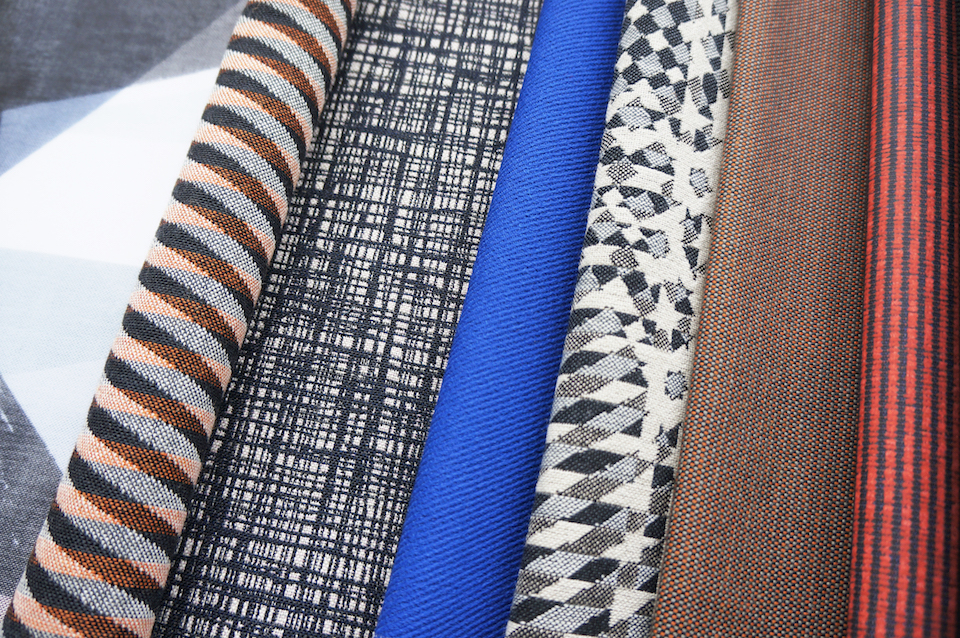
AOI YOSHIZAWA (Japan)
Aalto University School of Arts, Design & Architecture, Helsinki
Random Order, 2013–14
technique: jacquards in wool/polyamide & Trevira CS
For my MA graduation project, I have created a collection of textiles for public environments (contract textiles). The collection’s concept expresses a visual story for public spaces featuring the structural patterns of architecture and the echoing random movements of people. Based on this idea, I created intuitive patterns and structures in yet a systematic order by adding new expression to my previous design style.
In addition to the visual story of public spaces, this collection takes inspiration from the technical limitations and restrictions of the contract textile design process, as order also refers to rules and systems to be followed and obeyed. In this way, I considered limitations and restrictions as a valuable source of inspiration.
The collection consists of six upholstery designs and a curtain design in three different colorways. The technique used for the upholstery fabrics is jacquard weaving. To design a curtain, I used digital printing on a woven sheer fabric.
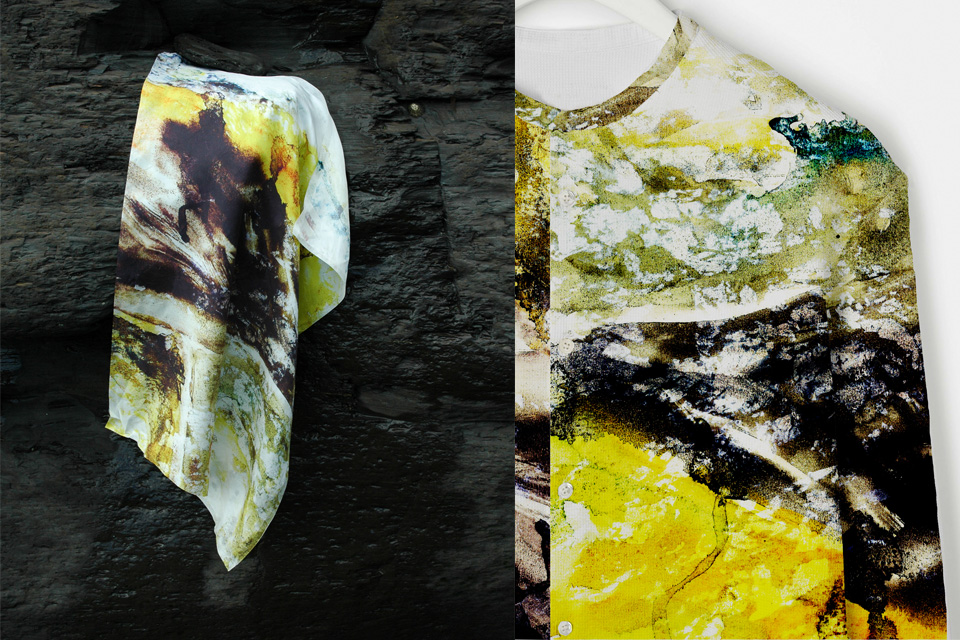
CARA MELLOR (Great Britain)
University of Huddersfield, England
Organic Element, 2015
technique: digitally-printed silk twill
In today’s fast paced society, so many beautiful moments occur within the natural world and go unnoticed. The concept behind this piece of fabric is to capture a moment in time. This could be wave movements, rain, snow or fire. These white moments in time should be celebrated and treasured, awakening the connection between humanity and nature. This sample shows wave recordings combined with original cave inspired paintings. The collaboration between art and textiles is evident as it is both conceptual and artistic. Designed for high-end menswear, I feel there is a cry for a new direction the menswear market which inspired me to explore innovative, unique design experimentation.
Movement and colour have been inspired by oceans in Australia. I used a practical method of recording the waves by painting ink onto fabrics and paper and watching the waves wash over them one at a time, focusing on the movement of the inks being drawn back by the wave. I rubbed sand into various test samples to add a natural texture to the surface. Natural fabrics such as silk worked well and absorbed the water, allowing the colours to set since the sea salt acted as a mordent. I combined these natural patterns with still life paintings of caves. The test samples were then developed using Adobe skills to enhance the colour, layer the textures and draw out the marks. This sample is digitally printed onto silk twill. Suit linings, shirts and knitwear are to printed, preserving the moment forever in my Organic Element menswear collection.
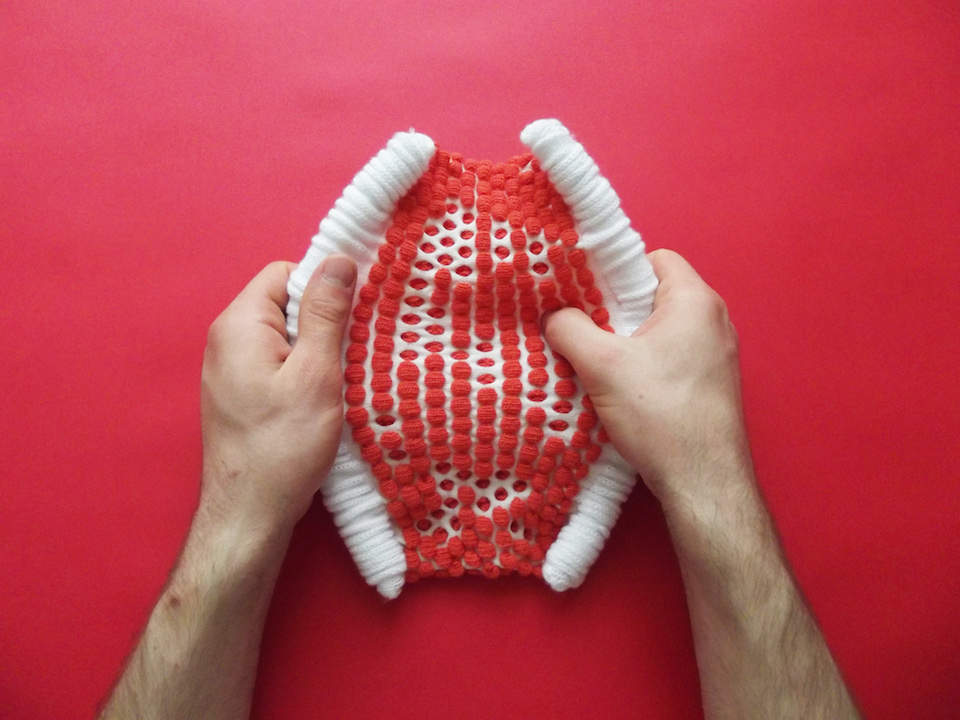
CAROLINE ANGIULO (Great Britain)
Central Saint Martins, London
Mind Wandering Bloom, 2014–15
techniques: dyed, crocheted, braided, twisted, knotted, gathered, wrapped & attached compositions in cotton, wool, acrylic, Lycra, foam, rubber bands & silicone tubes
How can we trigger mind wandering in our daily lives?
I am interested in the potential of materials to encourage a state of mind wandering. That is, allowing us to temporarily disconnect from technology and our everyday lives to provide a moment of light relief, while introducing an element of the extraordinary and fantastical.
Mind wandering occurs when you are executing an easy, repetitive, and relatively unstimulating task, enabling you to lapse into ‘task-unrelated’ thoughts. Research suggests that this state of mind is healthy for mental well-being and can help stimulate creativity. Just like the rabbit hole in ‘Alice in Wonderland’, or the taste of the madeleine in the novel ‘In Search of Lost Time’, these ‘wander materials’ aim to facilitate mental time travel through material design, evoking your imagination and providing a short escape.
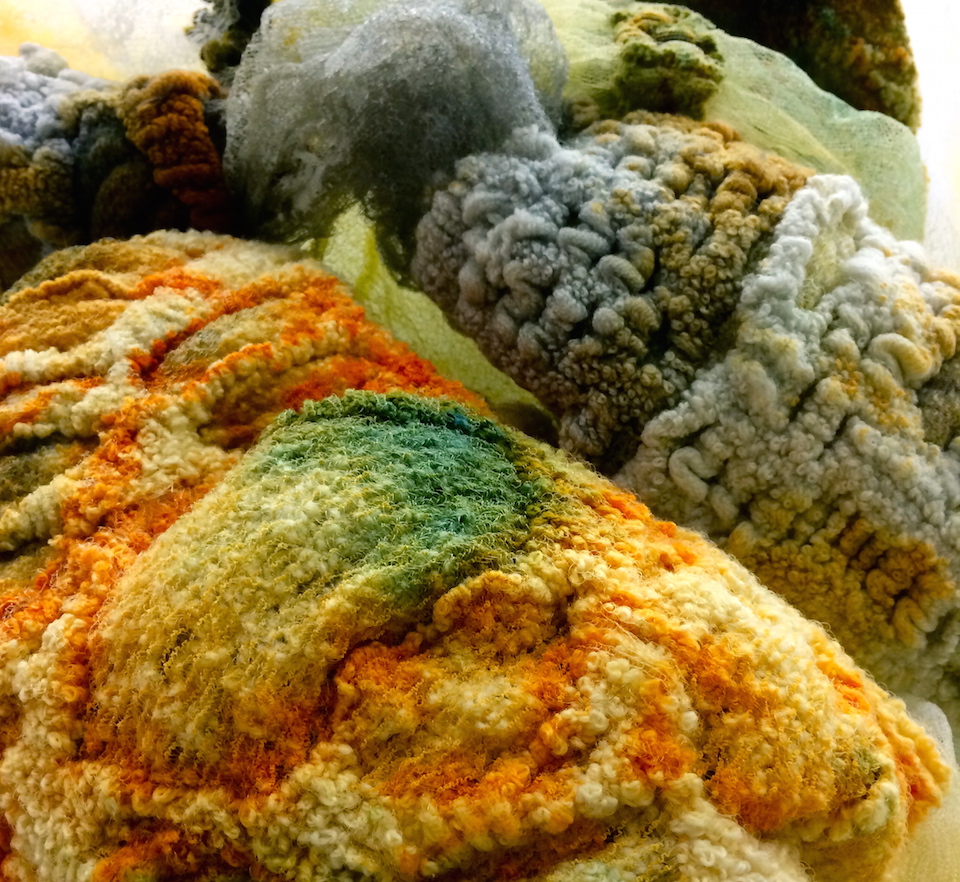
CHLOE COOPER (United States)
Rhode Island School of Design, Providence
Future Skins, 2014–15 (detail)
technique: monofilament machine knit, dipped in acid dye & rubber coating
For my thesis, I have explored the idea of manipulating human’s intrusion with evolution. In our culture, clothing is mainly worn for aesthetic purposes, and does not contribute to more of a progressive function for our movements and actions. These are very topical to our advancements in science and technology. Commenting on this, I created several ‘skin suits’, which will replace clothing in the future. These garments, when worn will transform the human body.
A person who has a specific part of their body that is failing their expectations, will be able to choose what parts of their bodies they would like to enhance, and put on this ‘skin suit’ that will fuse to their figure, transforming that particular highlighted area. I was intrigued by friends answers to ‘what would you change about your body for function and why?’ to create these specific bodysuits. Inspired by my sister’s answer of her stomach and problems with acid reflex, I created a stomach suit that will aid in smoother digestion, preventing stomach ulcers and acid reflex based off of research on how cows stomachs work.
I imagine a room set up like a future store, combining clothing with science, where people would be able to pick from a range of specimens which part of their body they would like enhanced, and have their own custom skin suit. In the future, we will be able to control our own bodies, instead of our bodies controlling us.
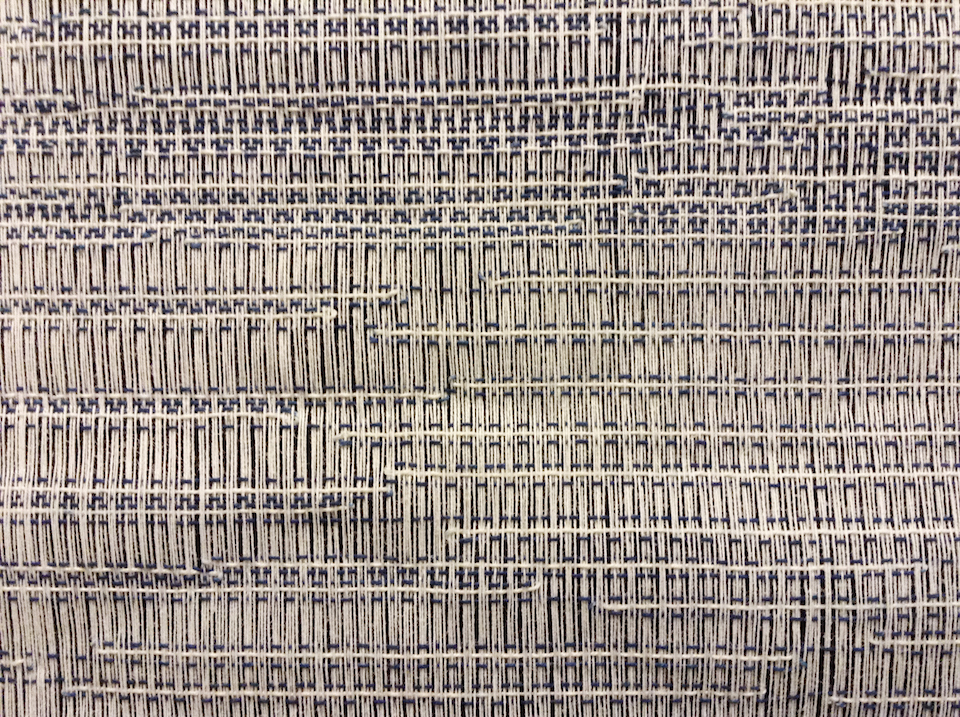
CHRISTINA MASCHKE (Germany)
University of Borås, Sweden
Deconstructed Ikat, 2015
technique: indigo dyed hand-weave
Ikat weaving has a long history and a rich cultural heritage. It’s an old textile technique where the threads are dyed and then woven into a fabric.
I used this traditional textile technique but approached it in a new and experimental way – letting the dyed weft tread lead its own way through the weaving structure. Therefore creating a deconstructed structure with a fragile appearance.
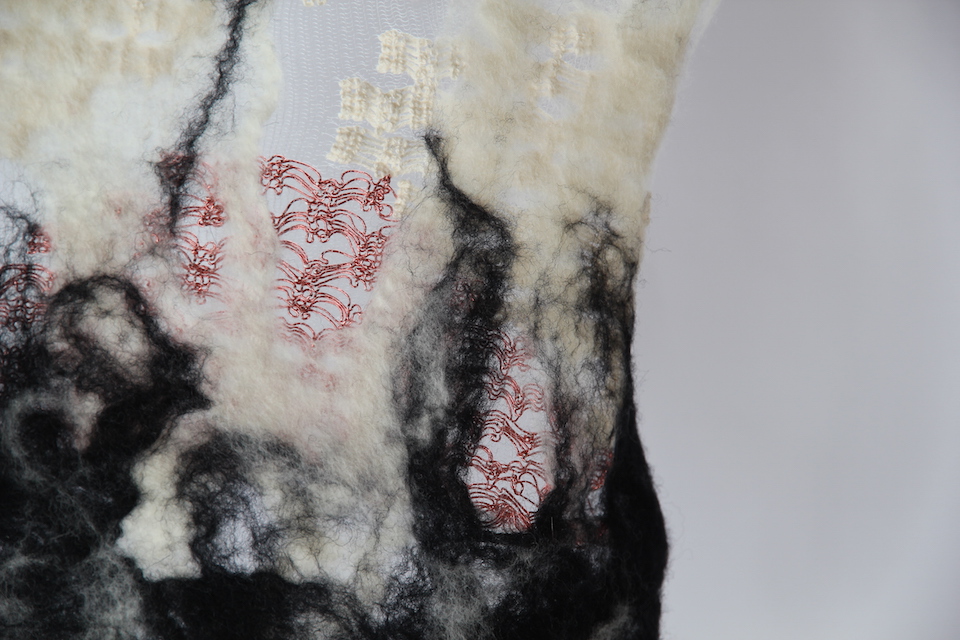
CLAIRE BLABY (Australia)
RMIT University, Melbourne
Convergence, 2015
technique: machine knit, hand felted in merino wool with nylon, cotton & metallic yarns
In biology, convergence is “the tendency of unrelated animals and plants to evolve superficially similar characteristics under similar environmental conditions” or “a location where airflows or ocean currents meet, characteristically marked by the upwelling (of air) or downwelling (of water).”
In this hand felted wool swatch, laces made of cotton, nylon and metallic yarn are interwoven to create multiple layers of tactility; mirroring our current interest in embedding different elements to create a hybrid – a cultural collage that merges the natural with the synthetic.
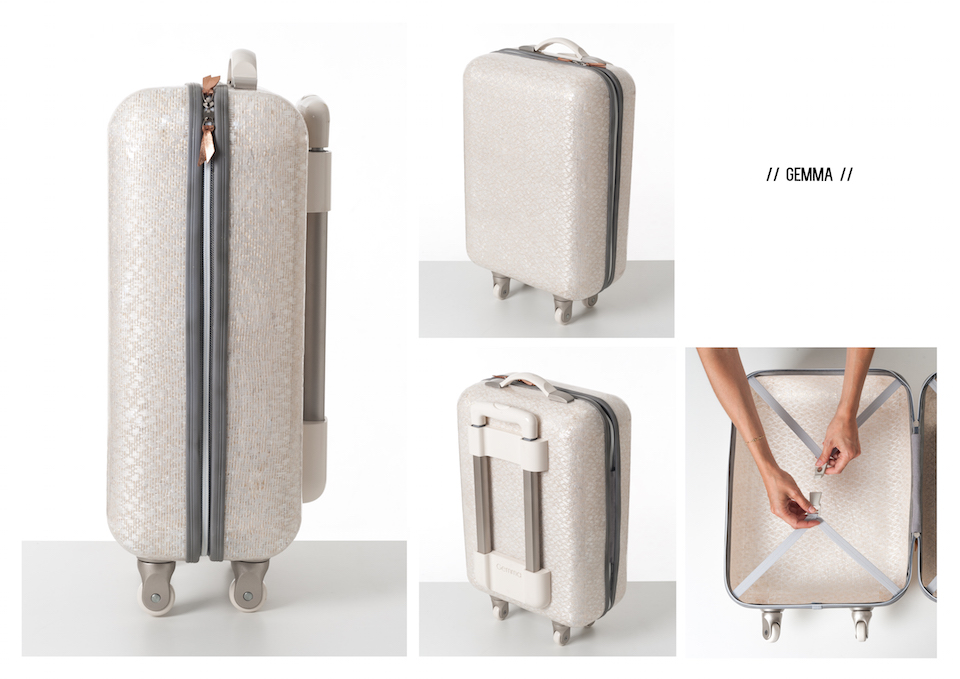
DANIELA ALVES (France)
ENSCI – Les Ateliers, Paris
Gemma, 2014
technique: handwoven polypropylene tape
Textiles are a means of communication, often what we see first, sometimes even before we consider the object’s utility. That’s why the surface is, as important as the meaning of the object; textiles give an orientation to our appreciation. The heart of my project was to reach a harmonization between perceptions of quality and quality of use.
Eager to find new proposals and responses in the luggage market, this project aims to use material innovations to best suit travel needs – needs which are constantly evolving (lighter, stronger, easier to use). The choice of textiles and materials used is, therefore, a critical one. My project proposes a union between the hard-case trolley and its textile counterpart; making a hard-case by weaving a plastic material.
The plastic used is Polypropylene tape; woven, this material can be self-reinforced and used in the thermoforming process. That way, my woven fabric can directly become a hard material and be manipulated into the desired shape. This material has the advantage of showing excellent impact properties as it also has bulletproof and blast protection applications. This aspect makes the woven polypropylene suitable for luggage, as it is extremely resistant to shocks. It is a real technological advance as luggage made from this material is said to be the strongest and lightest ever made. The textile collection developed here was inspired by gems – their refined sheen and texture.
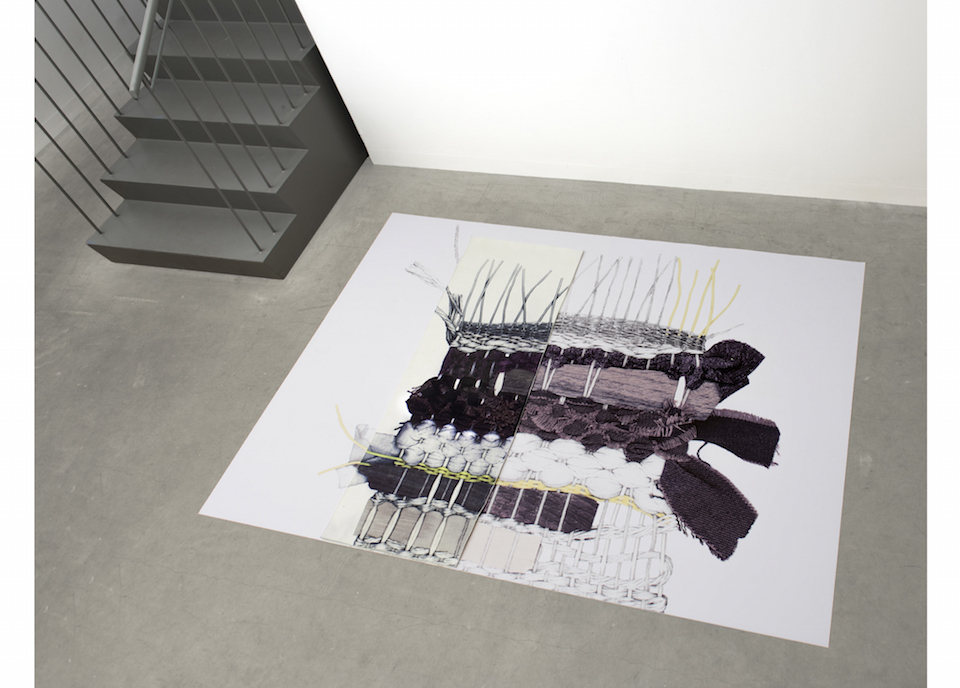
GITTE LÆGÅRD (Denmark)
Design School, Kolding, Denmark
Up Close Rugs, 2013
technique: digital print of hand-weaves on wool felt
This project grew from an interest in visualising authenticity in textiles. The word authenticity has been very popular and used in a lot recently. But what does it mean if something is authentic and how can I visualise it in terms of my profession?
My inspiration came from a meeting with an older man and his home with ticking clocks everywhere, rough walls, dust, mess and a lovely joy that permeated the entire house. I made my first studies on a children’s weave. It was a quick and immediate way to examine materials and expressions, but I thought the samples were too primitive. I therefore went quickly to a larger weaving machine.
After a series of experiments, I realised that the textiles were too perfect, all life in them had disappeared! The initial children’s weave pieces, with their coincidences, gravity and lots of mistakes, radiated the sensuality that I was looking for. I sensed the hand’s presence, and it stood in contrast to the monotonous mechanical expression.
For the finished blankets, I chose to use giant oversizing. I scaled images of the small weaving samples to massive proportions and printed them on thick wool felt, which gave a huge depth to the motif. The magnified expression overwhelms and surprises, and the rugs invite you to explore the entire area. The combination of the crafted look with modern print techniques creates an interesting tension in the rugs.
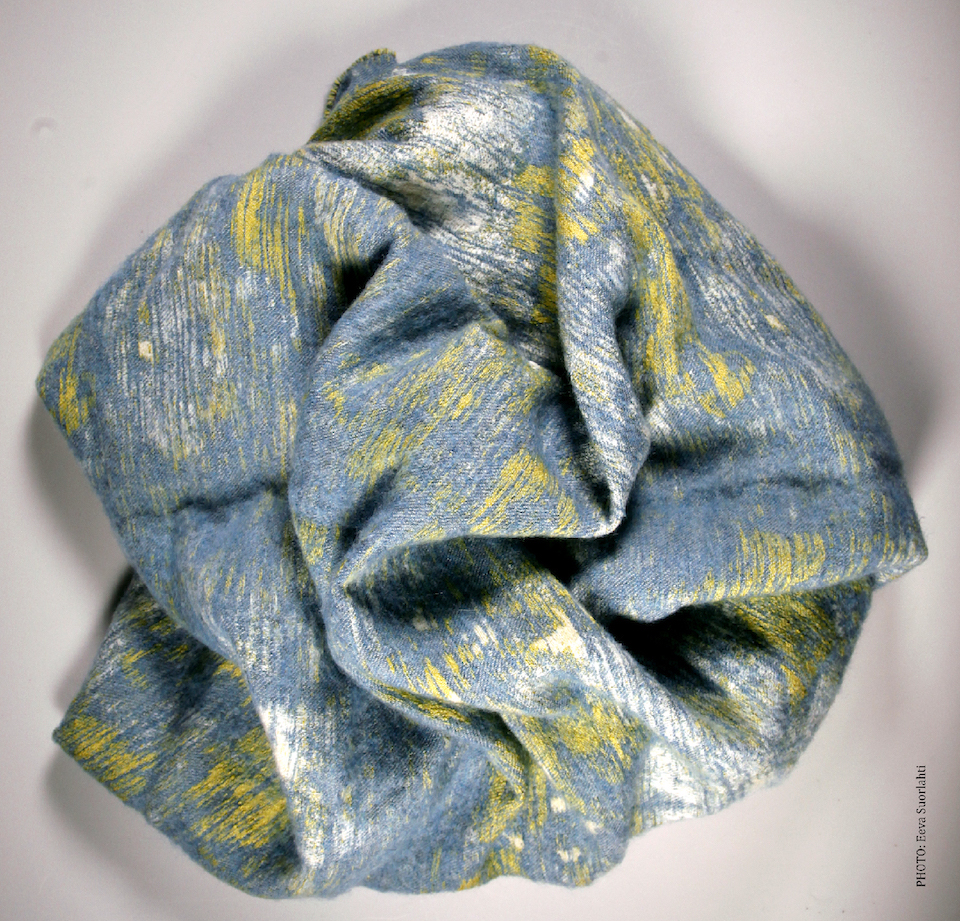
HANNA-KAISA KOROLAINEN (Finland)
Aalto University School of Arts, Design & Architecture, Helsinki
Daisies and Friends, 2014
technique: grattage on handwoven & industrial jacquards on mohair, wool & silk blends
I’m interested in testing different sketching methods in order to achieve varying results. In this jacquard fabric, I have used the scratching method. The very same technique we all learned in kindergarten, at least here in Finland. First I draw a picture with oil pastels, then I cover it with darker colour. After that I reveal the hidden picture by scratching the surface with a needle. The resulting image now has multiple layers and becomes more 3-dimensional.
For weaving I used a 3-weft system: I used one weft color similar to the warp to give a fresh effect. The warp is off-white cotton, and the wefts are dusty blue and white mohair, mixed with straw yellow wool-silk. The textile is scratched horizontally and bindings vary frequently on the surface of the fabric. Lines create an effect that resembles an old tapestry. Both sides of the fabric can be used as the front face.
I was interested of creating something that looks old and new at the same time. The lines made by the grattage-technique create an illusion of used fabric. This is the way that I face the idea of creating ecological textiles, when you fall in love with something that already looks some way old, you don’t mind when it actually will get aged. Choosing good quality materials, which will only become more beautiful with time, is part of my design philosophy. I design textiles that feel soft and comforting to touch.
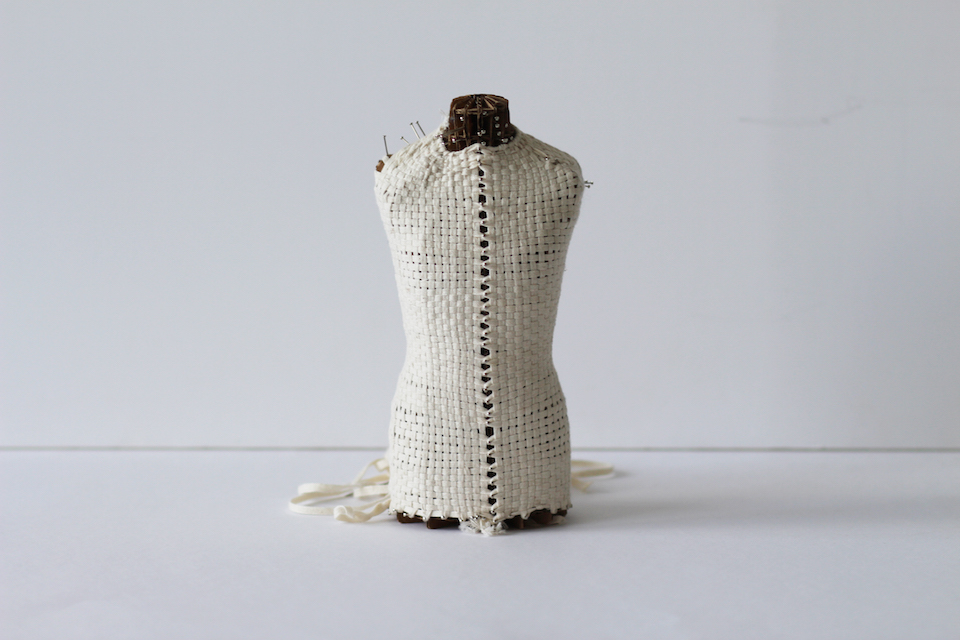
JACQUELINE LEFFERTS (United States)
Royal College of Arts, London
Mannequin Loom, 2014
My project challenges the status of makers. It is also meant to challenge designers’ acceptance of tools without questioning the tool’s efficiency or modern relevance. Why is fashion subservient to weave? Why do fashion designers always take the fabric from weavers and cut into it? Why is design separate within itself? Why can’t garments be woven the same way they can be knitted?
The project shown is a mannequin loom; a tool that allows materials to be directly woven onto a form creating a seamless 3-dimentional woven structure and simultaneously making a garment. The form is taken from a 3-D scan of a male mannequin, which was laser cut from cardboard. My ambition is to replicate this in wood and create a stand so it can be rotated whilst being woven. The material used to weave directly onto the mannequin loom is expensive tape yarn but I intend on experimenting with different materials and leather.
I currently only have access to a jacquard loom with a 12” repeat. In order to do this to scale I need to work with a mill that has a single repeat jacquard loom, meaning there is no size restriction.
I have also been exploring how to make this method accessible for mass production, such as on a jacquard loom that intersects and simultaneously weave pattern: three-dimensional garments can be woven in what appears to be a flat piece of cloth, before simply needing to be cut and turned inside out, eliminating the sewing process. Not only does this method reduce waste, it also eliminates steps from the supply chain, reducing the carbon footprint.
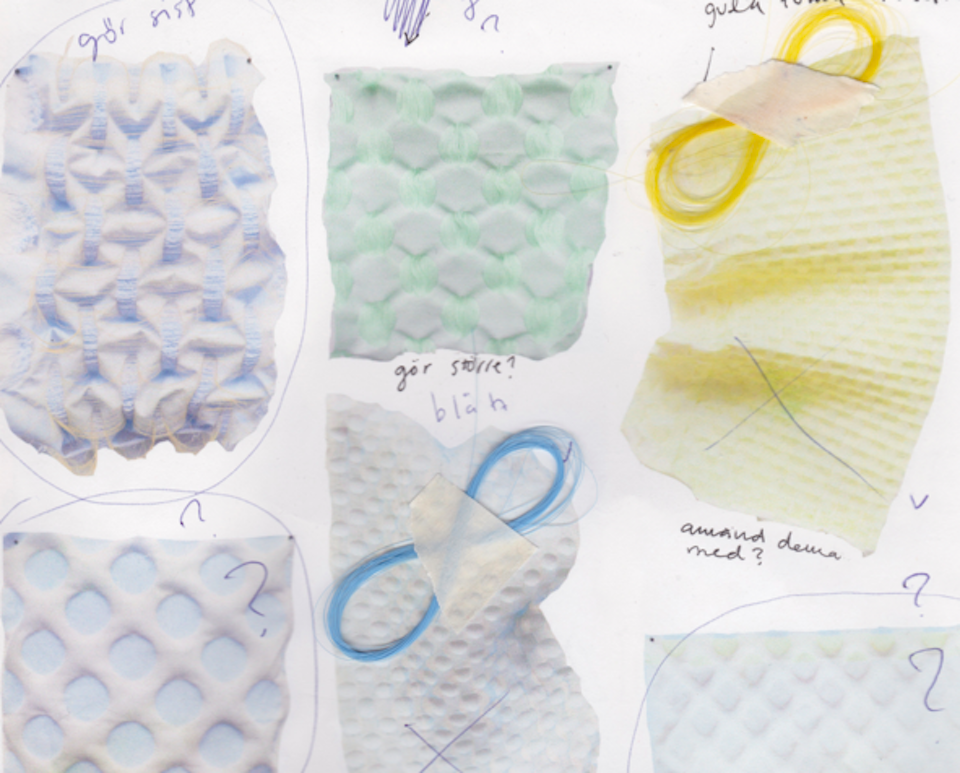
JOHANNA DE RU (Sweden)
University of Borås, Sweden
Satiprick, 2015
technique: various industrial jacquard weaves
This project investigates the relationship between one pattern, jacquard weaving and materials. With the aim, to find new expressions within in the field of woven textile design, as well as alternative ways of approaching the textile design process.
My ambition has been to fully explore one pattern and its expressive potentials in relation to weaving, yarns, density and scale. Through putting emphasis on the yarn and technique exploration, unexpected three-dimensional surfaces were developed, but also, a deeper knowledge of the inherent properties of materials.
The polka dot pattern has throughout the process functioned as a conceptual framework, but also, as the structure and expression of the result.
During my earlier bachelor and master education, I have deepened my knowledge of both traditional handicraft of weaving, but also how to manipulate and handle the industrial jacquard machine. With the intention to use the machine as a sketching tool rather than a production tool, and in extension, build a close relationship between the hand and the machine.
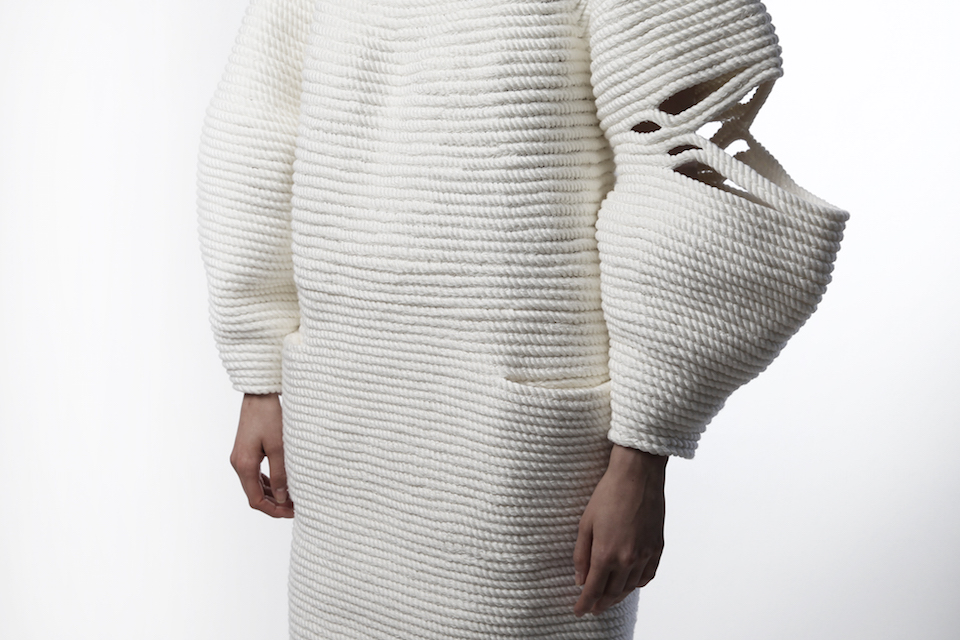
KATHERINE MAVRIDIS (Australia)
Parsons, The New School for Design, New York
Mokuba, 2014
technique: fully fashioned rope garments
I am a knitwear designer based in New York City. After my undergraduate degree at the University of Sydney, I was accepted into both Parsons the New School for Design and the Royal College of Art to complete a Masters in Fashion Design, majoring in knitwear.
For Mokuba, I developed a technique of coiling rope into fully fashioned three-dimensional garments which resemble a knitted construction. This graduate collection is currently on show at the Parsons graduation show in Manhattan.
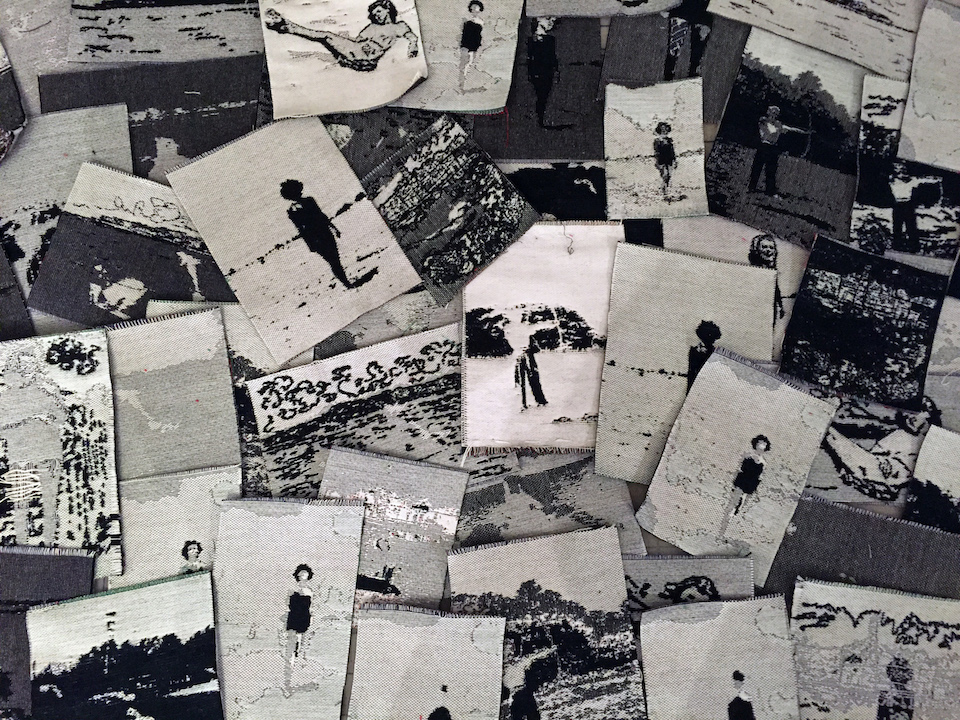
KELLY BOGAN (United States)
College of Textiles, North Carolina State University, Raleigh
Ruth Joseph, 2015
technique: cotton woven on an electronic Staubli jacquard loom 3 colorway
software using Photoshop, Kaledo Print & EAT
The intimacy of a memory is often lost in translation. The act of remembering is recreating a story with a mental photocopy. Research has proven that the more often a person remembers an event it will be further distorted from the pure truth of that event. Each time a memory is recreated in the mind elements change and certain parts are mis-remembered.
This collection of woven photos is an interpretation of how the memories would look today. The intricacy of a woven textile is a romantic medium for this collection because the sum of every yarn and every weave pattern create the visual of this new memory.
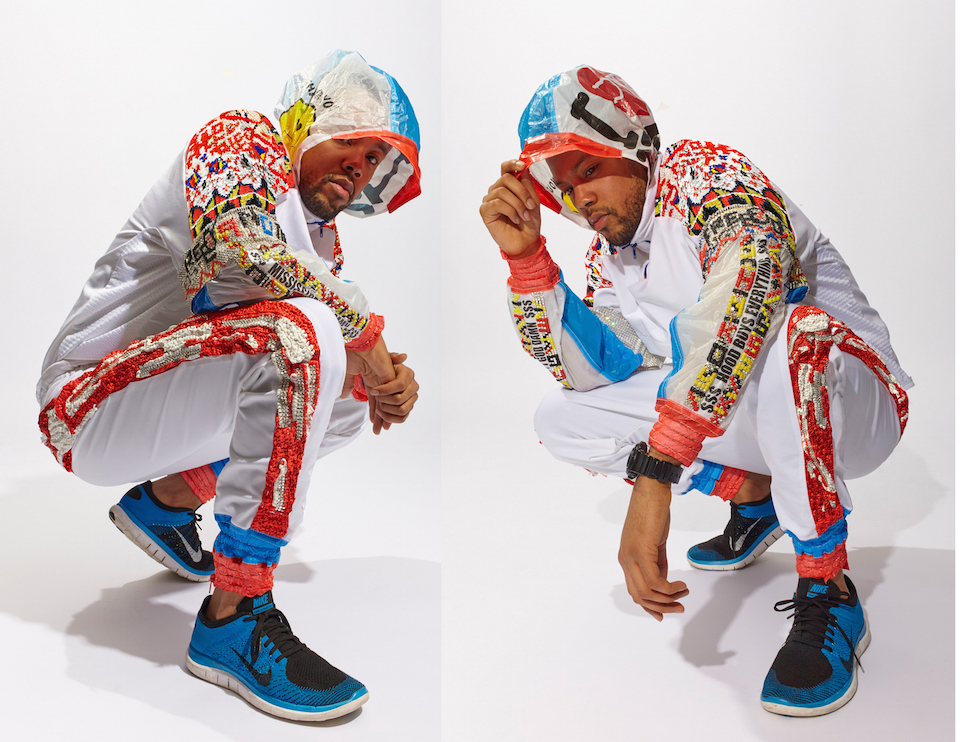
MARIA KAZAKOVA (United States)
Parsons, The New School for Design, New York
Playground of Americas, 2015 (in progress)
technique: mixed media including crystals, plastic bags, mirrors, stones, newspapers & organza
It is a duty of an artist to reflect the times. I see fashion as a powerful tool that can help bring attention to the problems that we face in the society, through cloth we can empower people, build workplaces, develop craftsmanship and provoke important conversations. Craft and creativity have no colour, no language, no religion. Today we have got to look at our past and to learn on mistakes in order to move forward. People of all nations must unite for the benefit of the whole, so that we can give to one another. Building one royal tribe.
I seek to reestablish ‘ethnics’ in a contemporary way, reconnecting people to the knowledge of the past and promoting hand skills and craftsmanship. Bringing ethnicity out of its costume status, to make it desirable, elevating the value of craft, clothes and materials. I want to rebuild the power and pride of formerly oppressed communities by developing traditional skills and creating employment. Craft empowers people and brings souls back through making.
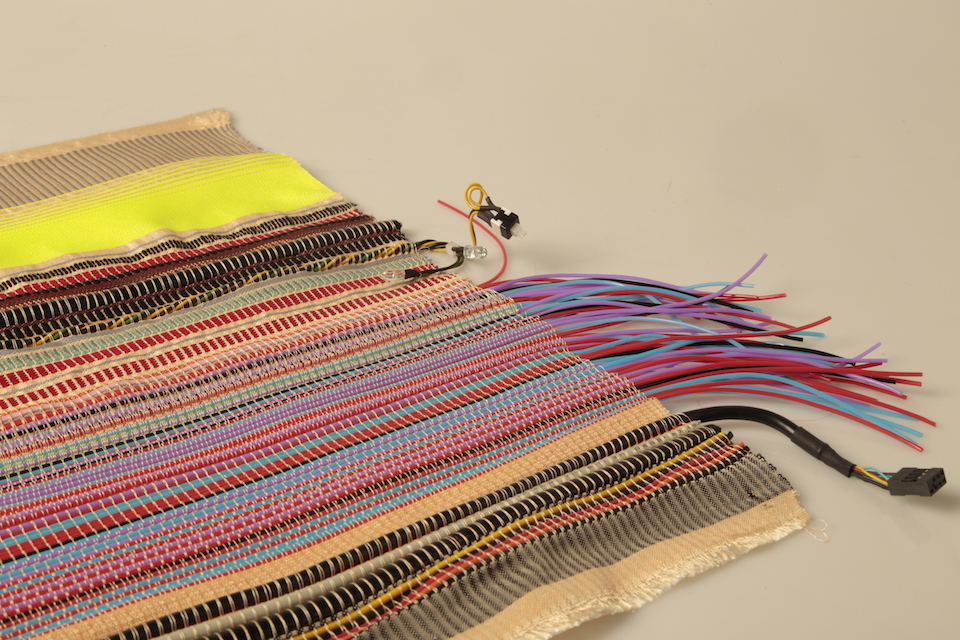
PIERO D’ANGELO (Italy)
Central Saint Martins, London
Hybrid, 2014
technique: I weaved my samples mostly with polyester threads combining fleshy colours with others bold and industrial, recycling plastic threads, wire, ropes and incorporating cables found in the computer.
These two designs form part of a five part collection made at the beginning of this year. I have explored the theme of Psychokinesis “a psychic ability allowing a person to influence a physical system without physical interaction.”
I started researching about people that claimed to have psychokinetic powers, but the heart of the project was to investigate what could happen in our brain if this could be possible and if not, perhaps it would be with the help of new technologies.
I experimented with materials such as liquid latex, plastics and wire and deconstructing a computer not just to understand its mechanical process, which somehow could be compared to our brain that works like a machine, but recycling and adapting some of the parts in my samples as well, giving to them another function.
For one of my samples I weaved hair extension threads and used liquid latex for the finishing, trapping the end of the warp in the liquid latex precisely. I cut the hair creating many neat and asymmetric layers. I used techniques such as twill, crêpe, diced, honeycomb and distorted weave effect. I created patterns inspired from my research through the extra figuring technique to give some of the samples a 3D relief. The result is a hybrid between human and machine.
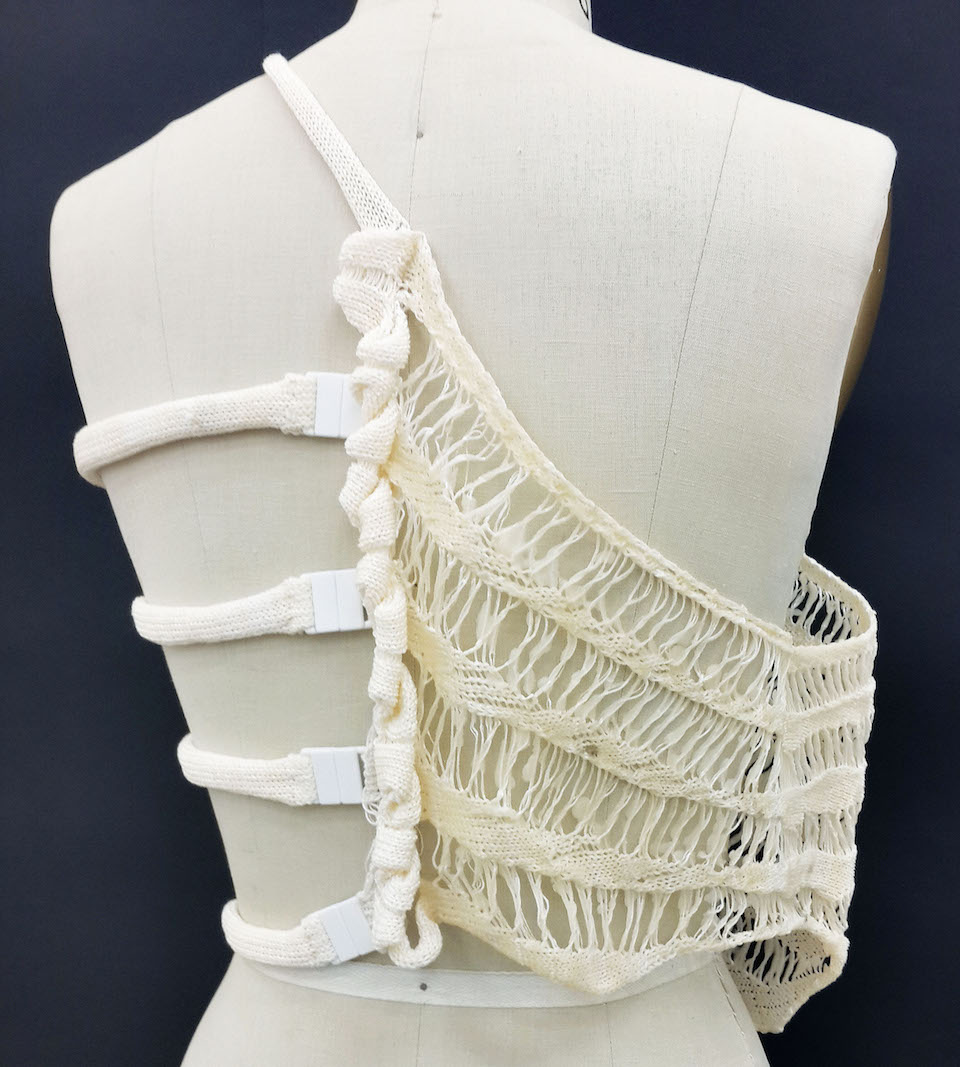
TATIANA ELKIND (Israel)
Shenkar College of Engineering and Design, Tel Aviv
Skeletons In My Closet, 2013
technique: partial knitting on a manual knitting machine in cotton with wax hardening in sections
I’m currently in my senior year for Bachelor’s degree, Textile Design at Shenkar College of Engineering and Design. My specialisation is knitwear.
I believe that designers should always put in their work something out of their inner world and self. All that we experience in life affects what our hands do. In my projects and knits I love mixing two (or more) worlds, cultures, inspirations.
I love adding bright colors to black and darkness or darken sweetness. I’m drawn to historical and magical themes and inspirations and try to bring that in my work.
I love telling stories through the pieces I make. I usually wear black and I’m pretty much a cynical person but my works and projects are full of color and truth.
These sculptural pieces are inspired by bones and twisted spines, thinking about wearing the “skeletons in your closet”, secrets, shame in our society.
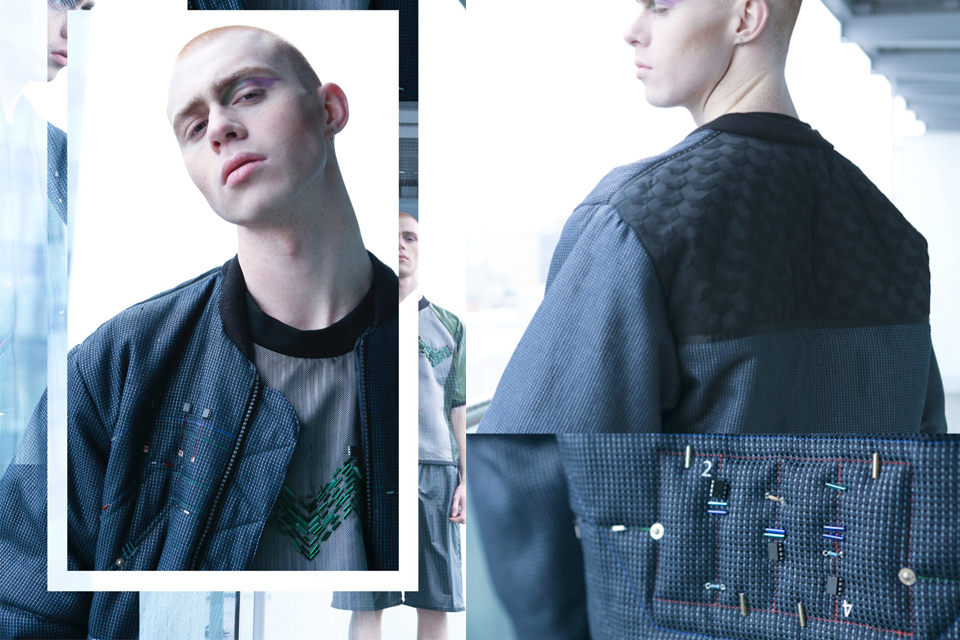
ZAKI MUSA (Great Britain)
London College of Fashion
Chipboard Circuit, 2014
technique: mixed media hand & machine embroidery
Drawing inspiration from random access memory (RAM), these textiles speak a story of a lost tribe of boys, integrating ”old technology” into their everyday lives. The collection deals with ideas around sustainability and waste, combined with the value of craft and tradition in a digital age.
For the Circuit Bomber I used assorted beading, combined with tech chips and hand-turned resistors to form beads. The numbers were “printed” out with cut vinyl. The textile was then machine quilted with metallic embroidery thread. For the Aztec Pattern I incorporated beading onto silk tie fabric, with bugel beads, aventurine beads, resistors hand-turned and tech chips. And to make the Resistor Shorts, I hand-turned resistor beads, forming details along the sides of the shorts.
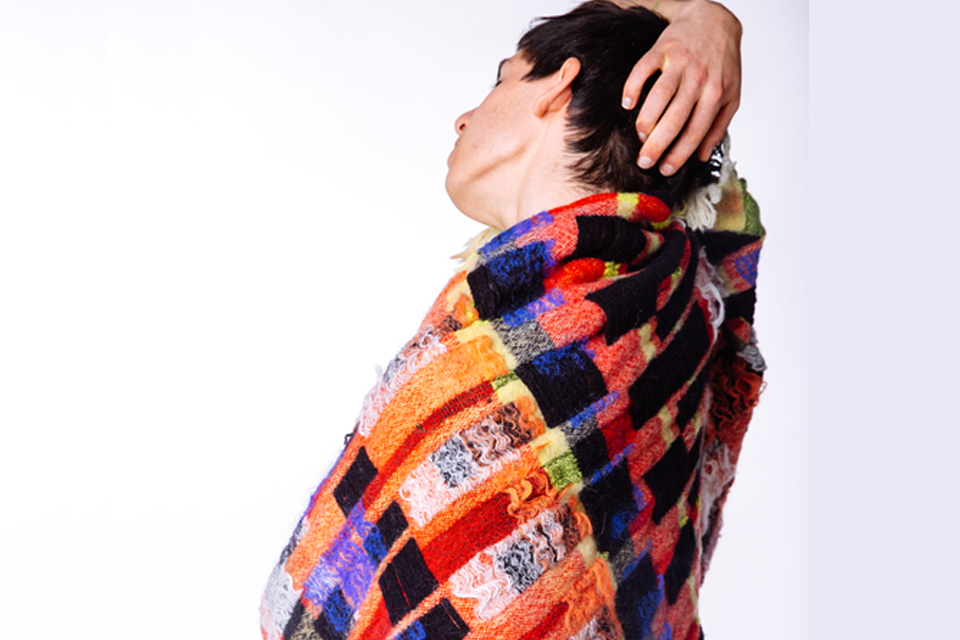
ZOE CLARK (United States)
Rhode Island School of Design, Providence
Madness Woven, 2014
technique: woven wool, mohair & rayon
My work seeks to represent the phenomena and nuance of our world through material, texture and color. I imagine the fiber as a paint brush of sorts, using the inherent structure of fabric as a medium to bridge the imagined with the physical world. Reality, identity, light, memory and culture are important in my work.
This piece is part of a collection of woven blankets that explore the idea of “madness”. I was particularly inspired by Freud’s explanation of the sub-conscious; Egon Schiele’s angular, contorted self-portraits; Klimt and anatomical photography developed in Vienna 1900.
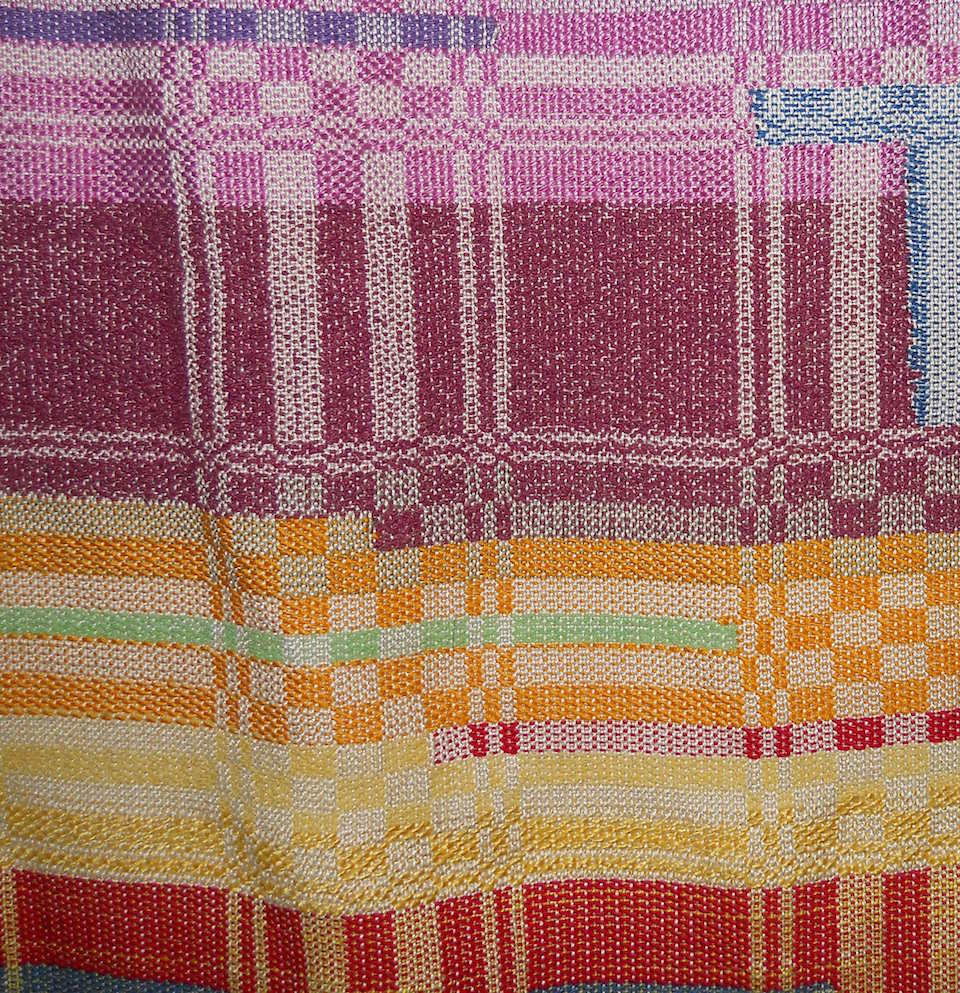
KATHERINE MITCHELL (United States)
Fashion Institute of Technology, New York
The River That Flows Both Ways, 2014
in memory of Pete Seeger, 1919 – 2014
technique: handwoven silk with inlay & tapestry techniques
Peter “Pete” Seeger was an American folk singer and activist. A fixture on nationwide radio in the 1940s, he also had a string of hit records during the early 1950s as a member of the Weavers, most notably their recording of Lead Belly’s “Goodnight, Irene”, which topped the charts for 13 weeks in 1950. Members of the Weavers were blacklisted during the McCarthy Era.
In the 1960s, he re-emerged on the public scene as a prominent singer of protest music in support of international disarmament, civil rights, counterculture and environmental causes.
The weft is recovered yarn, primarily remnants from tapestry projects and unraveled items. It forms part of a larger body of work I have worked on during my studies at F.I.T.
